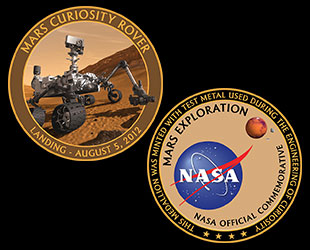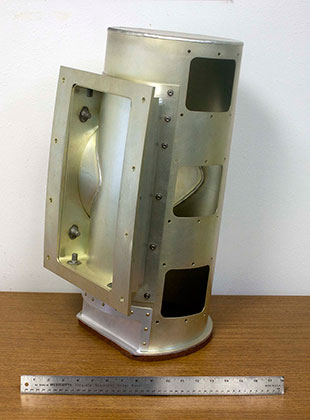August 5, 2013 — NASA is marking the Curiosity rover's first year on Mars with a commemorative medallion minted from metal used in the engineering of the robotic explorer.
NASA's Mars Science Laboratory (MSL) with its Curiosity six-wheeled rover landed inside Mars' Gale Crater on Aug. 6, 2012 (EDT and GMT; Aug. 5, PDT) after a nine month journey from Earth. The car-size, one-ton Curiosity is the largest roving vehicle ever launched to the Red Planet.
Within its first 12 months exploring Mars, Curiosity met its major science objective, finding the evidence for a past wet environment that was well-suited to supporting ancient microbial life.
Entering the second year of its planned two-year mission, the rover is trailblazing a path to the base of Mount Sharp, the 3.4-mile-high (5.5-kilometer) mountain that rises from the crater's center. Once there, Curiosity will continue its investigation into how the Mars' environment changed and evolved.

Color artwork for NASA's Mars Curiosity Rover medallion. (Winco) |
NASA's Curiosity medallion features a raised depiction of the Mars rover with its drill-equipped robotic arm stretching into the design's outer border. The dimensional rendering captures the Curiosity rover's laser-outfitted camera mast and is detailed enough to make out the custom tread on one of Curiosity's wheels (the pattern leaves behind tracks that spell out "JPL" in Morse code).
The front of the 1.75-inch diameter (4.4-cm) medallion is inscribed "Mars Curiosity Rover" and "Landing - August 5, 2012," the latter noting the date of the rover's touchdown as recorded at NASA's Jet Propulsion Laboratory (JPL) in Pasadena, Calif., where Curiosity is controlled.
NASA's insignia doubles as the Earth as rendered on the reverse of the medallion. The agency's emblem is offset by a raised depiction of Mars and its two moons, Phobos and Deimos.
Inscribed along an inner border are "Mars Exploration" and "NASA Official Commemorative." An inscription along the outer border reads: "This Medallion Was Minted With Test Metal Used During The Engineering Of Curiosity."
Added to the antique copper used to mint the thousands of medallions was the metal from an engineering test unit for Curiosity's lower environmental control system (LECS) tee-duct. The LECS was designed for the MSL to cool the Multi-Mission Radio-Thermal Generator (MMRTG), which serves as Curiosity's nuclear power source.

NASA's Mars Curiosity Rover medallion was minted using metal from this engineering test unit tee duct from the Mars Science Laboratory's lower environmental control system. (Winco) |
Winco International of California produced the medallions for NASA and oversaw that the metal from the test tee-duct was incorporated into the minting process.
"Winco's mission in producing the Curiosity medallion was to create an official commemorative that would be worthy of the program it represents," Andy Boston, president of Winco, said. "The resulting design and dimensional quality has truly exceeded our expectations."
Though primarily minted for NASA's use, Winco has made some of the Mars Curiosity Rover medallions available to the public through select distributors.
The Mars Curiosity medallion is the latest among a series of similar commemoratives produced by Winco for NASA. The company, which also provides the agency's official lapel pins, has minted medallions for the 40th anniversary of the Apollo missions, the 30-year space shuttle program, and the aeronautic achievements pioneered at the Dryden Flight Research Center.
